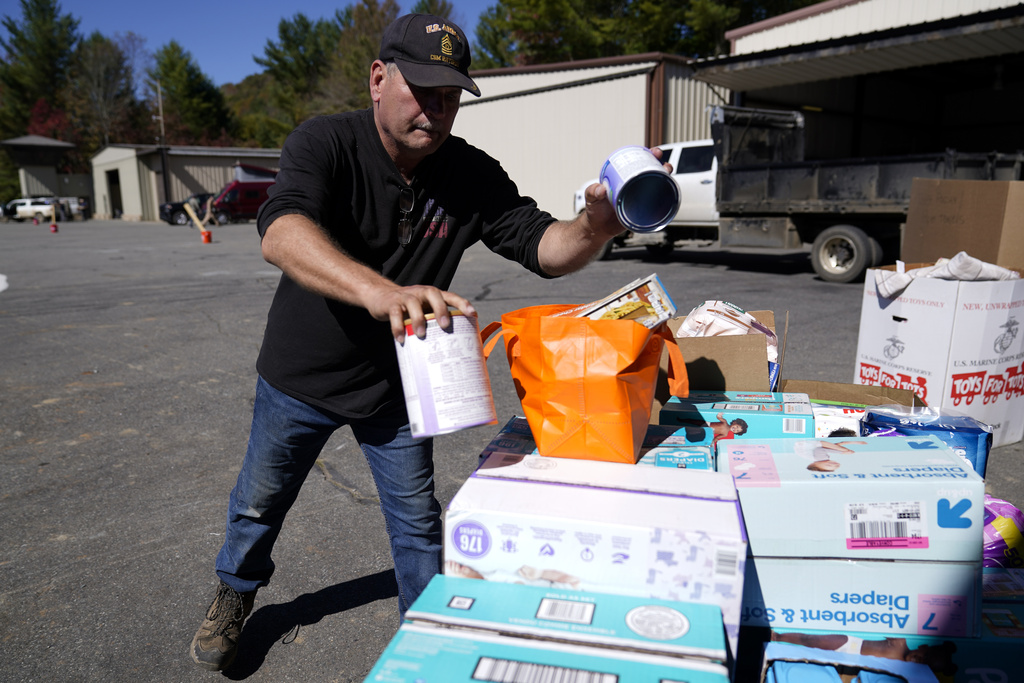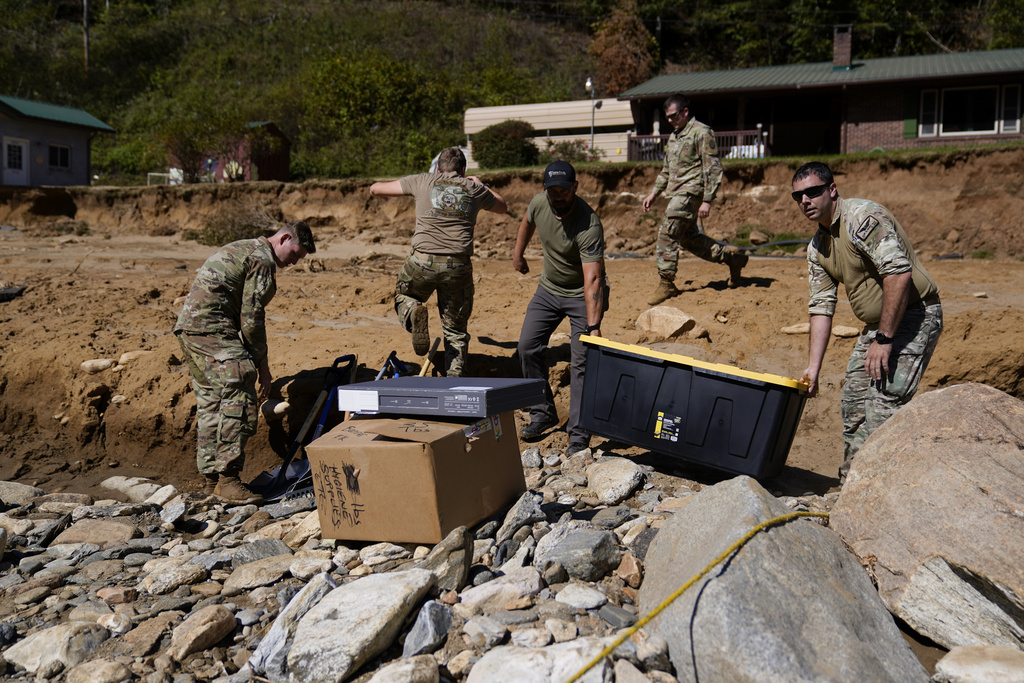National Guard Delivers Aid to Isolated NC Towns After Helene \ Newslooks \ Washington DC \ Mary Sidiqi \ Evening Edition \ In the wake of Hurricane Helene, rural communities in North Carolina like Ramseytown are struggling to recover. With bridges destroyed and roads blocked by landslides, National Guard helicopters are the primary source of aid. As temperatures drop, these communities face new challenges in their fight for survival. Cold-weather supplies and local volunteers are stepping in to help, but the devastation remains overwhelming. Aid efforts are further complicated by difficult access to these remote mountain regions, which were heavily impacted by the storm.

North Carolina’s Post-Hurricane Helene Relief Efforts: Quick Looks
- National Guard helicopters deliver vital supplies to isolated mountain communities in North Carolina weeks after Hurricane Helene struck.
- Destruction from landslides and flooding has rendered many areas, like Ramseytown, inaccessible by road, leaving residents stranded and reliant on airlifts for aid.
- With cold weather approaching, there is an urgent need for winter gear, heaters, and supplies in impacted communities.
- Local churches and volunteers have become central to disaster relief efforts, working alongside the National Guard to distribute essentials.
- Residents and volunteers are using creative methods, including horses and mules, to deliver aid to those cut off from help.
Deep Look:
In Ramseytown, North Carolina, the descent of a Black Hawk helicopter kicks up clouds of dust and debris, momentarily blinding those gathered near Byrd’s Chapel Baptist Church. As the dust settles, the wreckage of the community becomes painfully clear—what was once a peaceful area is now strewn with twisted metal, shattered trees, and rubble. The once grassy fields, as shown in Google Street View images taken just a few months ago, are now unrecognizable, marked by landslides and flooding.
On the muddy banks of the Cane River, local residents and National Guard members work together to distribute critical supplies to those stranded on the far side of the river. Since Hurricane Helene hit the region in September, many residents of Yancey County have been cut off from the outside world, as landslides and the storm’s destruction took out key bridges and roads. The National Guard has become a lifeline for these isolated communities.
Chief Warrant Officer 3 Jonathan Behuniak of the National Guard described the challenges, saying, “With the landslides and the destruction, it took out most of the bridges along this river. There’s really no access from the outside world.”
National Guard Airdrops Critical Supplies
With more than 6,000 Guard members deployed across the Southeast in response to Hurricane Helene, daily operations have been focused on delivering food, water, and now, cold-weather supplies to remote areas. Each mission is determined by the immediate needs of the local communities. In Ramseytown, a yellow rope strung across the Cane River allows a resident to pull an inflatable boat to ferry supplies to those on the far side. A submerged red truck is a stark reminder of the now-destroyed bridge that once connected them.
Two Associated Press journalists joined the National Guard for an airdrop to the region, documenting the efforts to provide aid. The Guard’s helicopter missions have become vital for communities like Ramseytown, where nearly all access has been cut off by the storm.
But as Hurricane Helene’s immediate devastation gives way to the long road to recovery, priorities are shifting. In addition to delivering food and water, the Guard is now bringing in heaters, winter clothing, and camping stoves to prepare residents for the approaching cold.
Looming Cold Weather Presents New Challenges
For people like Jerry Markland, the approaching winter is a new and pressing concern. A resident of Avery County, Markland has seen firsthand the havoc that Hurricane Helene wreaked on his community. As a registered nurse, he worked tirelessly in a hospital that had no power, water, or communications in the days following the storm. He also helped his elderly mother escape her damaged home, navigating through waist-deep mud to get her to safety.
Markland has survived one disaster after another, including a landslide that nearly swept him away. “You will never forget the sound of an avalanche of mud coming down the side of your bank,” he recalled.
But now, with temperatures set to drop next week, Markland is worried about the families who have lost their homes or had them severely damaged by the flooding and landslides. The cold weather will bring a new layer of hardship for those already struggling to recover from the storm’s devastation.
The National Guard brought in $6,000 worth of cold-weather gear, including heaters and camping stoves, which were donated by a local construction company. These supplies were delivered to Elk Park Christian Church, where Markland and other volunteers have been distributing aid to surrounding communities.
“We’re doing everything we can to get people ready for winter,” Markland said, as he and his team worked to unload the supplies from the Guard’s helicopter.
Local Volunteers and Churches Step Up
While the National Guard plays a critical role in the disaster response, local churches and volunteers have been shouldering much of the relief effort. Since Helene struck, places like Elk Park Christian Church have become makeshift distribution centers, where trucks and U-Hauls deliver food, clothing, and medical supplies.
Alex Nelson, a retired non-commissioned military officer, has taken charge of operations at the Elk River Airport, where relief efforts are coordinated. Since arriving last week from Yadkin County, Nelson has been sleeping in his car, organizing volunteers and deliveries around the clock.
“This area will not be defined by getting smacked in the mouth,” Nelson said. “What it will be defined by is what they’ve done after they got smacked in the mouth.”
At the airport, volunteers load massive totes with community care packages, which are then distributed by truck or, in some cases, by small planes and helicopters piloted by locals. Every day, around 100 bags of supplies are delivered to families in need.
Alternative Methods of Aid Delivery
In some areas, airlifts aren’t enough to reach those stranded by the storm. Volunteers like Kelly Ryan and Racquel Starford have traveled from Virginia with their three horses and a mule to help deliver supplies on foot to remote areas where helicopters cannot land. The pair plans to spend the next week in Ramseytown, working to get supplies to families cut off by landslides and downed trees.
“We’re just trying to go where help is needed right now,” Starford said, noting that they would be working as long as needed to ensure that the most isolated communities receive aid.
Landslides and Flooding Transform the Landscape
In Ramseytown and other mountain communities, the aftermath of Hurricane Helene has left a surreal and often treacherous landscape. Landslides have transformed entire hillsides, while rivers that once flowed calmly now surge through what were once homes and roads. The destruction has been so widespread that residents have been forced to adapt to a new reality.
“This is like nothing we’ve ever seen before,” said Jonathan Behuniak of the National Guard, referring to the collapsed bridges and treacherous roads that once connected these mountain towns.
In some cases, the landscape has made conventional aid delivery impossible. Kelly Ryan and Racquel Starford’s horses have allowed them to traverse the steep, muddy terrain to reach those stranded.
Long Road to Recovery
Weeks after Hurricane Helene wreaked havoc on North Carolina, recovery remains a slow and painstaking process. The destruction, compounded by the region’s already rugged terrain, has made accessing these communities a challenge. As winter approaches, the urgency to provide aid is greater than ever.
The National Guard’s deliveries remain a critical lifeline for these isolated towns, but local churches, volunteers, and even animal power are also playing vital roles in ensuring that relief reaches the people who need it most.
Despite the ongoing challenges, residents and volunteers remain resilient. As Nelson put it, “We’ll rebuild, but it’s going to take time. The damage here won’t define us—the way we come together will.”
National Guard Delivers National Guard Delivers National Guard Delivers







